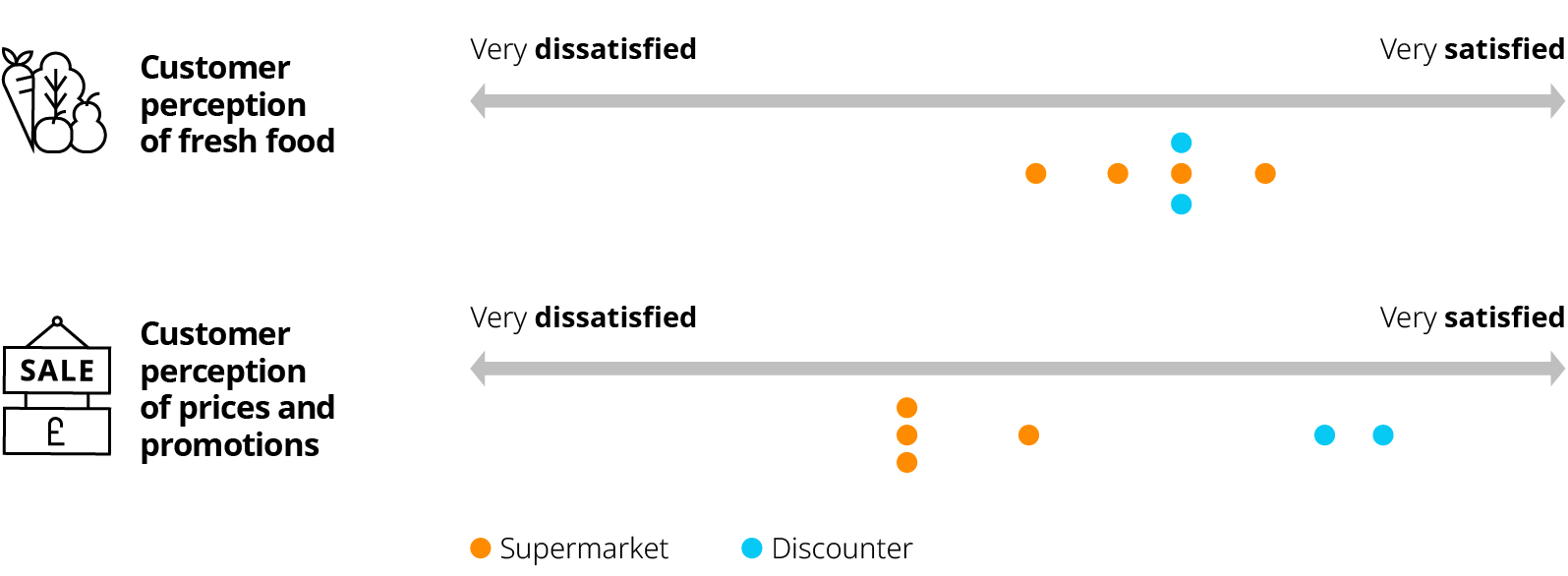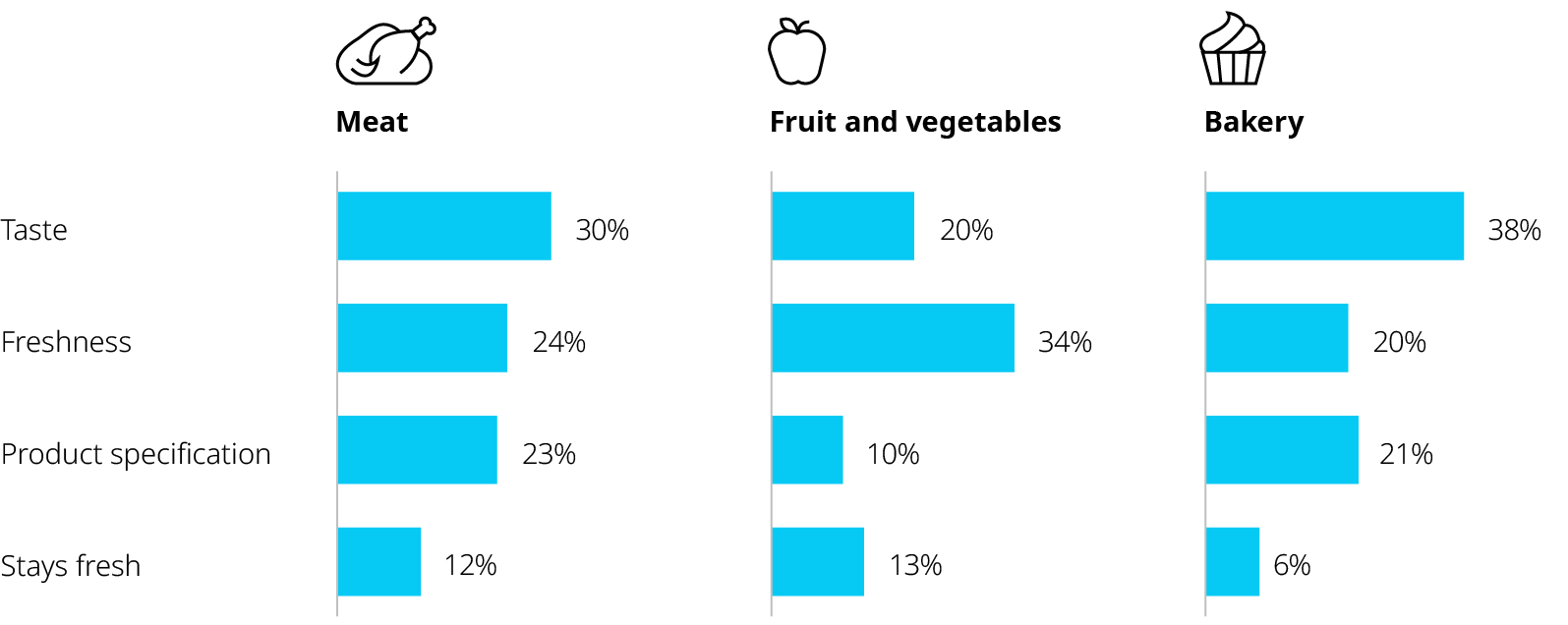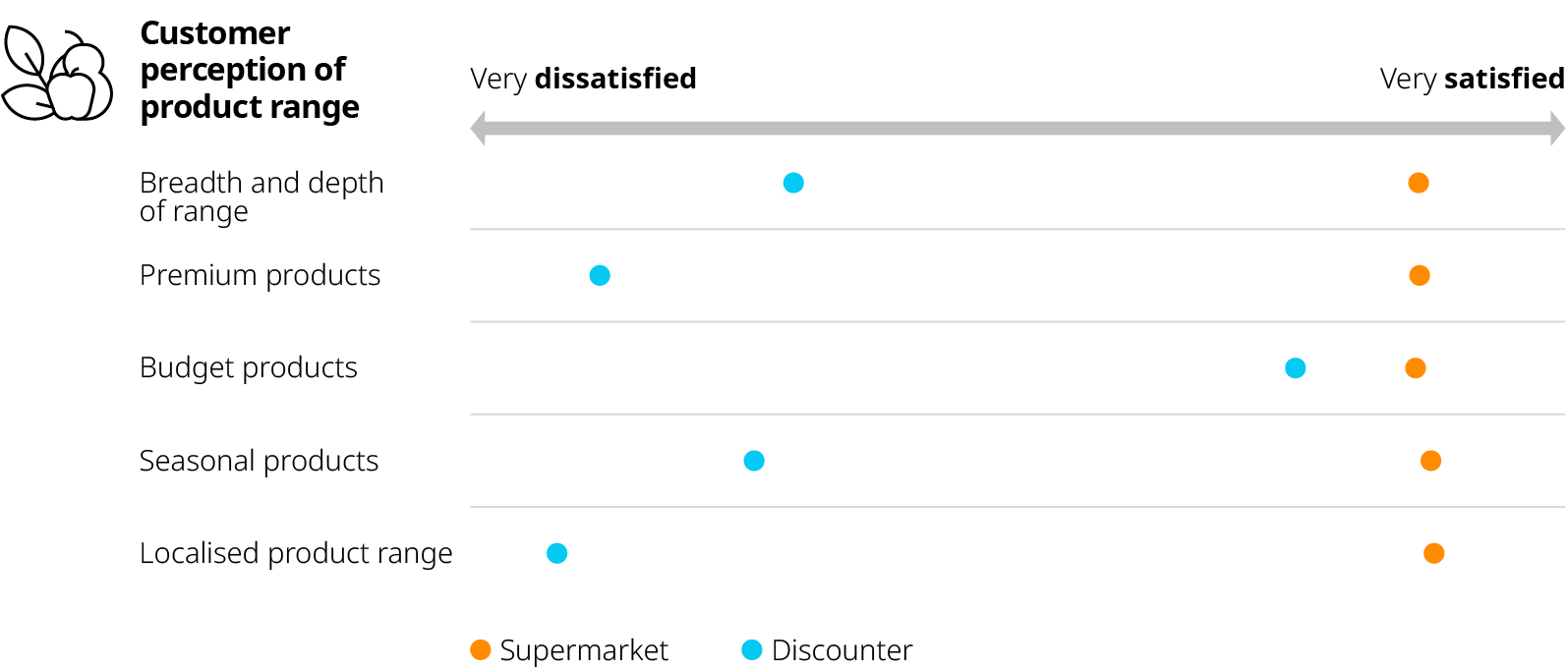Fresh food is increasingly important for UK consumers when choosing where they shop. We conducted a survey of more than 1,500 shoppers to quantify how fresh food attracts customers and can be used to help grocers stand out from the competition.
This article highlights the major observations from our survey and the key lessons for grocers.
SURVEY FINDINGS
Satisfaction with the fresh category determines where customers shop
For 54 percent of British consumers, the most important reason for choosing a supermarket is the quality of its fresh food: meat, fish, fruit, vegetables, bakery, cheese, and ready meals. Seventy-three percent of British consumers return regularly to the store they consider best for fresh products, and 43 percent are willing to change store if they are not satisfied with the fresh products.
Satisfaction with fresh food boosts traffic and spend
Fresh food has a high impact on how much UK shoppers spend. Customers satisfied with a store’s fresh food offering spend 74 percent more than those who are unsatisfied. Furthermore, excellence in fresh food supports sales in other categories: A £1 increase in spend on fresh food is correlated with a £1.23 increase in total sales.
Price differences in fresh food are clear to shoppers but don’t matter as much as product quality
Customers view fresh food from discounters as just as good as that from UK supermarkets and are more satisfied with fresh food prices at discounters (see Exhibit 1). However, only 7 percent of survey respondents said that prices and promotions are the most important consideration when buying fresh food. Instead, it is the quality of the produce that determines customer satisfaction (see Exhibit 2).
Exhibit 1: UK Customers View Discounters’ Fresh Food As The Same Quality As Supermarkets’ At Better Prices

Source: Oliver Wyman UK Fresh Survey
Exhibit 2: Factors That Drive Customer Satisfaction In Fresh Food

Source: Oliver Wyman UK Fresh Survey
Taste is an important dimension of quality
A common misconception is that quality is defined by looks for fruit and vegetables and expiry date for meat. These factors are significant but quality is becoming the norm, especially in terms of products’ visual appearance. Our survey shows that taste is important too: It is already the biggest factor in determining consumers’ perception of the quality of meat and bread and is a growing factor for fruit and vegetables (see Exhibit 3).
Exhibit 3: Factors That Drive Customer Satisfaction With The Quality Of Fresh Foods

Source: Oliver Wyman UK Fresh Survey
Customers undervalue supermarkets’ extensive product ranges
The big four UK supermarkets have a noticeable strength in the product range they can offer customers (see Exhibit 4), but just 11 percent of customers’ satisfaction with fresh food depends on this (see Exhibit 2). To better take advantage of their strength in assortment, supermarkets must understand what their customers want in each store and then adapt to those demands. They should also strive for as many exclusive products as possible.
Exhibit 4: Supermarkets Have An Advantage In The Product Range They Offer UK Customers

Source: Oliver Wyman UK Fresh Survey
Customers seek an emotional connection with a store
Interaction between customers and store staff plays an important role in how customers view the store. In the UK, 49 percent of customers said service counters are important for their choice of supermarket. Moreover, 76 percent of customers who buy products at these counters are satisfied with the retailer’s fresh food, compared with 57 percent of those who don’t. Shoppers who use counters also spend 67 percent more on fresh food. Staff working in the fresh food section also provide an opportunity for human interaction, which can make shopping a more personal and pleasant activity.
In North America, satisfaction depends far more on product presentation than in Europe. Leading retailers in the US are aware of this and use theatrical presentations to connect emotionally with their customers. If they can cut costs elsewhere, we expect to see UK retailers investing more in presentation and atmosphere.
Physical retailers have an advantage over online competitors in fresh food
Online grocery shopping is more popular in the UK than in any other market we surveyed, with 38 percent of consumers having already tried online shopping with home delivery for fresh groceries. However, 55 percent say either that they wouldn’t buy fresh food online again or they are not interested in doing so because they want to see, smell, and touch fresh products before buying them.
The three biggest reasons for consumers not choosing to buy fresh food online are: the desire to see and try out products, the difficulty of assessing quality and freshness online, and the fear of receiving low-quality products. Brick-and-mortar stores therefore have a chance to differentiate from online competitors through their fresh food offerings.
FROM INSIGHTS TO ACTIONS
Based on our findings, we have identified nine ways that supermarkets in the UK can generate a competitive advantage from their fresh food categories. The first four actions are focused on the customer proposition; the next five look at how these can be enabled by changes to the way the business operates.
Customer proposition
- Let customers know you have the best-quality fresh products possible available in store.
- Cater to local demand and impress with relevant innovations.
- Automate store tasks that customers don’t see or value.
- Invest in areas that create an emotional connection with customers.
Business operations
- Vertically integrate the fresh food supply chain.
- Automate local space allocation and assortment using state-of-the-art algorithms and machine learning.
- Forecast shrink and availability better by using machine learning.
- Use smart labour scheduling to ensure support is available at the right times for fresh counters, restocking, and activities that matter most to customers.
- Attract and retain the best talent to work in the fresh food team.
CONCLUDING REMARKS
Significant advances in fresh-food retailing cannot be achieved simply by improving a few functions, such as purchasing or the supply chain. Instead, a holistic approach is required, in which the entire system is optimised for customer satisfaction.





